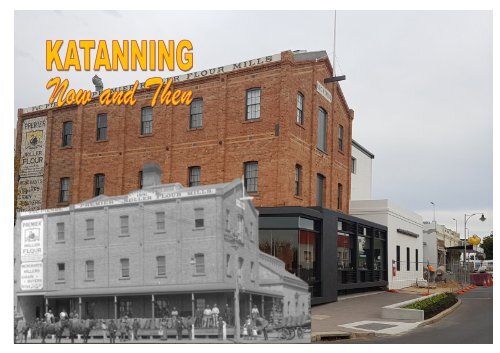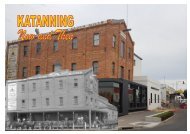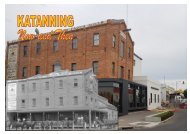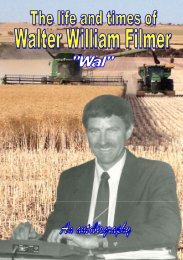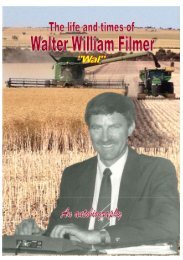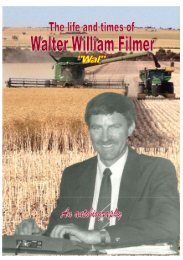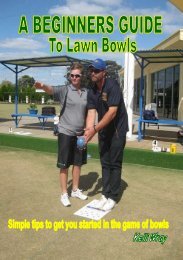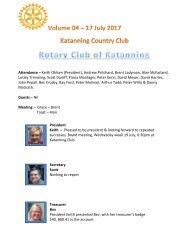NOW & THEN BOOK
a PICTORIAL HISTORY
a PICTORIAL HISTORY
You also want an ePaper? Increase the reach of your titles
YUMPU automatically turns print PDFs into web optimized ePapers that Google loves.
Frederick and Charles Piesse<br />
Frederick Henry Piesse<br />
Frederick Henry Piesse, CMG (6 December 1853 – 29 June 1912) was a farmer, businessman and politician who<br />
is credited with much of the early development of the region around Katanning, Western Australia.<br />
Frederick was born at Northam, Western Australia, on 6 December 1853, the son of policeman and magistrate<br />
William Roper Piesse and Elizabeth Ellen née Oxley. Among his brothers were Alfred, Arnold and Charles, all of<br />
whom would follow Frederick into politics. Piesse was educated at state schools at Guildford and Northam, and<br />
began his working life at the Northam general store. He later went pearl fishing at Shark Bay between 1872 and<br />
1875. He was postmaster and telegraphist at Williams between 1875 and 1880. On 18 October 1877 he married<br />
Mary Jane Elizabeth Chipper, with whom he would have four sons and a daughter.<br />
In 1880, Piesse partnered with his brother Charles to launch the general produce firm of F. & C. Piesse at<br />
Williams. He set up a portable store in 1886, and followed the progress of the Great Southern Railway, finishing<br />
up at Katanning. He then bought agricultural land near the railway and, in 1891, built the flour mill in Katanning.<br />
He established a wine industry, making wines that won awards in Perth, London and Paris.<br />
From 1880 onward, Piesse became increasingly involved in public affairs. He was a member of the Williams Road<br />
Board from 1880 to 1889, and its chairman from 1886. In 1889 he became a Justice of the Peace, and from 1889<br />
to 1896 he was on the Katanning Road Board. From January 1894 to June 1896 he was also a member of the<br />
Board of Agriculture. At the 1890 election, Piesse was elected to the Western Australian Legislative Assembly<br />
seat of Williams, becoming a member of the first Parliament of Western Australia under responsible government.<br />
From 1 April 1896 to 23 August 1900, he was Commissioner for Railways and Director of Public Works in the<br />
Forrest Ministry. He was a Western Australian delegate to the Federal Convention of 1897 and, for a period in<br />
1900, he was Acting Premier of Western Australia. During George Leake’s first premiership from June to<br />
November 1901, Piesse was Leader of the Opposition.<br />
In the 1904 election, Piesse stood for and won the new seat of Katanning. He would hold the seat until his resignation<br />
on 26 October 1909. For his last four years in parliament he was Father of the House. Piesse was made a<br />
CMG in 1908. He died at Katanning on 29 June 1912, and was buried in Katanning Cemetery.<br />
Frederick Henry Piesse<br />
Charles Austin Piesse<br />
Charles Austin Piesse (11 November 1855 – 13 July 1914) was an Australian businessman and politician who<br />
served as a member of the Legislative Council of Western Australia from 1894 until his death. He was a minister in<br />
the government of Newton Moore.<br />
Piesse was born in Northam, Western Australia and after leaving school, Piesse was briefly involved in the<br />
pearling trade at Shark Bay with his brother Frederick, later purchasing a farm near Williams. In 1880, he went into<br />
business with his brother Frederick and formed the firm of F. &. C. Piesse.<br />
In 1887, Piesse was elected as the first chairman of the newly created Arthur Roads Board, serving in the position<br />
until 1890. He was elected to parliament at the 1894 Legislative Council elections, as a representative of the<br />
South-East Province. After his initial two-year term, Piesse was re-elected to six-year terms in 1896, 1902, 1908,<br />
and 1914. From 1906 to 1907, he served as a minister without portfolio in the ministry of Newton Moore.[1] Piesse<br />
died in Perth in July 1914. He had married twice, having nine children by his first wife (Martha Chipper) and three<br />
by his second (Flora Hickson). One of his daughters-in-law, Winifred Piesse, was also an MP.<br />
Charles Austin Piesse
Drawing from F&C Piesse’s official letterhead of 1905<br />
KATANNING ROLLER FLOUR MILL<br />
The Katanning Roller Flour Mill was built by brothers Frederick and Charles Piesse. The York firm of Thorne, Bower and Stewart<br />
erected the mill in 1891 and it was officially being opened on 1st May 1891. It was equipped with machinery supplied by Otto Schumacher<br />
of Melbourne. Head miller Charles Quigley carried out the installation of the machinery. The mill was to become the most dominant<br />
in the Great Southern region, having its production capacity doubled by 1909 and extensive alterations and additions in 1912.
KATANNING ROLLER FLOUR MILL<br />
The Katanning Roller Flour Mill, after the demise of the business in the 1970’s, lay dormant for many years and looked<br />
like being demolished. However the Katanning Shire took control of the building and, in 2015, sold it to the Dome Coffee Group<br />
for $1.00 on the proviso it was restored to its former state. The group set about refurbishing the building, turning it into a boutique<br />
industrial heritage hotel with a café and downstairs wine bar.
KOBEELYA<br />
Kobeelya was erected for F H Piesse in 1902, as the family’s private residence and built to overlook their property and the town.<br />
The name, suggested by Sir John Forrest, is an aboriginal word which means “place of sleep and rest”. Kobeelya passed out of the hands of the<br />
Piesse family in 1922, becoming the boarding house and schoolrooms of the Church of England’s Kobeelya College and later Penrhos College.<br />
This school for girls, opened on 14th September 1922, was unique by allowing students to bring their horses with them.
KOBEELYA<br />
Since taking over Kobeelya, the Katanning Baptist community has worked hard raising<br />
funds to restore the building to its former glory. The temporary walls on the second<br />
floor have been removed, the interior refurbished and, in 2016, the exterior was completed.<br />
The community uses the complex for worship and as a retreat.
ROGERS CENTRAL STORE<br />
The
ROGERS CENTRAL STORE<br />
The
Alexander (Alec) Thomson<br />
Alec Thomson came to Western<br />
Australia in 1895 working as a<br />
Journeyman. In 1896, he married<br />
Edith Maud Jenkinson, and they had<br />
four sons. He moved to Katanning in<br />
1905 where he opened a timber and<br />
hardware store known as Thomson<br />
and Melany. At the 1914 state<br />
election, Thomson was elected to the<br />
seat of Katanning and was the<br />
Country Party’s deputy leader in<br />
1921. He was a director of the<br />
Katanning Flour Mill, founder of the<br />
Katanning Fresh Air League and<br />
Katanning Historical Society, and<br />
was active in local affairs.<br />
William John Rogers<br />
William John married Hannah Mary<br />
Pinkerton and they had seven<br />
children. In 1901, William arrived in<br />
Katanning and set about establishing<br />
his store. He was a very successful<br />
retailer who began with modest<br />
premises and expanded into his<br />
larger Central Store. He purchased<br />
CA Harris’s Central Store in Clive<br />
Street and, by 1904, Rogers was<br />
ready to build his own much larger<br />
premises. In July 1904 tenders were<br />
called for the new Roger’s Central<br />
Store, the architect being FW Burwell<br />
of Fremantle. The building still<br />
dominates Clive Street today.<br />
Elijah Quartermaine<br />
Elijah is considered to be the first<br />
settler in the district of Katanning.<br />
In 1851 he was grazing 1,900 sheep<br />
and, finding abundant water and feed<br />
for his sheep in the area,<br />
Quartermaine permanently settled<br />
being the first to secure land (1852).<br />
He named the property Yowangup,<br />
a name derived from a spring on<br />
his property. He married Elizabeth<br />
Dickenson on 20 November, 1835<br />
and they had 12 children.<br />
Descendants of Quartermaine still<br />
own and manage the property,<br />
which also has his grave on it.<br />
George McLeod<br />
George McLeod was a respected<br />
local businessman as the owner of<br />
the Katanning Hotel. F&H Piesse’s<br />
original hotel burnt down in 1893<br />
and was rebuilt on its present<br />
site in 1898.<br />
George McLeod Jnr purchased the<br />
goodwill and freehold of the hotel.<br />
He was also a member of the Roads<br />
Board and the Hospital Committees<br />
and was a political candidate for the<br />
Nationalist Party in 1914.<br />
McLeod built his residence in<br />
1912 and the family lived in it<br />
until the mid 1930s.
PIESSE’S KATANNING WINERY<br />
The Piesse family had established vineyards on their property as<br />
early as the 1890s. It was not until 1902 that the family<br />
employed a winemaker. This was Carl Bungert, who was<br />
selected by A. Piesse who was visiting South Australia.<br />
The original winery was erected in 1904 using bricks from the<br />
Piesse brickworks. A brick distillery with a basement cellar was<br />
added in 1910 and this is the only remaining structure. The tower<br />
housed four water tanks.<br />
The wine was very successful and not only was supplied to<br />
surrounding districts, but was also sold overseas. Wine was<br />
exhibited at the Perth Agricultural Society's Show and in 1904 it<br />
was awarded the Ferguson Challenge Cup. In 1908 the<br />
winery received a gold medal at the Franco-British Exhibition<br />
in London.<br />
The winery in production c1905<br />
Although the wine was to win many other awards, the death of<br />
F H Piesse in 1912 and eventful family mismanagement caused<br />
the Piesse family to sell off much of its property in the early 1920s.<br />
The wine cellar casks and tools were sold to New Norcia and to<br />
South Australia.<br />
It is believed that the vines contracted a disease not uncommon to<br />
wine producing vines.<br />
The family had a number of circumstances to contend with after<br />
the death of FH Piesse and it appeared they lost interest in the<br />
affairs of the business. The situation may have been beyond their<br />
control at the time.<br />
In 2004 the Historical Society of Katanning decided to sell the Winery.<br />
It was bought by A and M.E. Fritz, descendants of the Piesse family.<br />
The winery derelict c1965<br />
From the State Heritage Council’s inherit website
PIESSE’S KATANNING WINERY<br />
Today, even the partial walls in the background have gone and the water tower is all that remains.<br />
The remains of the winery were taken over by the Katanning Historical Society and, in 2004,<br />
the Society decided to sell it. It was bought by A and M.E. Fritz, great granddaughter of Frederick Piesse
KATANNING POST OFFICE<br />
In 1912 Mr J Park was the successful tenderer for the new post office<br />
situated in Clive Street opposite the Federal Hotel. The original building was constructed<br />
in 1892 of which A E Piesse was the first postmaster. The contract price for the new post office<br />
was £2482 / 4/ 10 and the building was completed in 1913, opening in April.
KATANNING POST OFFICE<br />
Today, the building still operates as Katanning’s official post office. The building in<br />
the background is the Katanning Telephone Exchange which plays an important<br />
role in Western Australia’s telephone and date network.
F&C PIESSE BUILDING<br />
The Piesse brothers first established a one-room store in<br />
the town of Katanning in 1889, at the time the Great Southern<br />
Railway was established. Owing to their success, they were<br />
later able to replace this with a more substantial wood and iron<br />
structure. In 1901 the Piesse complex was erected – the third<br />
and finest of their stores. The building was designed by<br />
E Summerhayes, of Perth, and built by J H Brown,<br />
the contract price being over £3000.<br />
From here the Piesse brothers continued their successful<br />
trading operations until 1904 when Robert Lawson Richardson<br />
entered into the partnership and the store became known as<br />
Richardson & Co.<br />
Richardson took the store into a very successful period,<br />
whereby other branches were being opened up all<br />
over the Great Southern and Richardson becoming a<br />
household name. As a result, a new wing was added<br />
to the store in 1908 to meet the demands. In 1924<br />
the business was floated into a limited company<br />
under the name of Richardson and Co. Ltd, with<br />
Richardson as the Chairman of the Board.<br />
Extensive additions and alterations were carried<br />
out to the building in 1927, costing over £8000,<br />
when the premises were purchased from the<br />
Piesse estate. The architects were<br />
Oldham, Boas, Ednie-Brown and the contractors<br />
were Hine & May.<br />
Top: F&C Piesse’s second store with the<br />
brother’s mill in the background.<br />
Right: The building as it was originally<br />
constructed in 1901
F&C PIESSE BUILDING<br />
This building is often referred to as the “Richardson” building although it was built<br />
by the Piesse brothers, Frederick & Charles. The wing containing the shop front to<br />
the left was added by Robert Richardson in 1908. Today, the interior has been gutted<br />
and now houses an arcade and retail shops.


